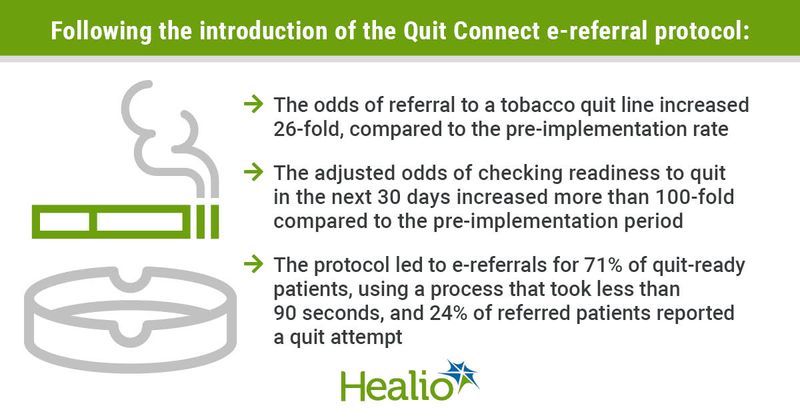Rheumatology staff-driven protocol boosts referrals to tobacco quit lines 26-fold
Quit Connect, an electronic health record protocol for referring rheumatology patients to tobacco quit lines implemented by staff at the University of Wisconsin, increased referrals 26-fold over a 6-month period, according to data.
“In many rheumatologic conditions, smoking predicts higher disease incidence, greater disease severity and reduced treatment response in addition to increased cardiovascular risk,” Christie M. Bartels, MD, MS, of the University of Wisconsin School of Medicine and Public Health, and colleagues wrote in Arthritis Care & Research. “Yet, while smoking is routinely assessed, cessation interventions are rare in rheumatology. Despite 50% to 60% higher cardiovascular disease (CVD) risk, we reported that cessation advice was provided in just 10% of RA visits; quit line support was recommended in 0.6% of visits.”

In an interview with Healio Rheumatology, Bartels put it more bluntly: “We routinely ask about smoking, but then drop the ball. This intervention matters because smoking associates with worse rheumatic disease and cardiopulmonary outcomes, making cessation support important but often overlooked.”
To analyze the implementation and impact of Quit Connect, Bartels and colleagues conducted a quasi-experimental, pre-post cohort study at three academic adult rheumatology clinics where the protocol was introduced. The researchers compared referrals to tobacco quit lines from 4 baseline years — October 2012 to March 2016 — to those during a 6-month period following Quit Connect implementation — April to October 2016.

As part of the Quit Connect program, nurses and medical assistants were trained to use two standardized EHR prompts to assess patients’ readiness to quit smoking within 30 days, advise cessation and point them toward quit lines via e-referral orders. For their study, Bartels and colleagues set the primary outcome as accepted referral to the quit line in patients identified as current smokers. All adult patients who resided in the state with a rheumatology visit and a positive tobacco screen were eligible.
In all, 4,601 patients, out of a total of 54,090 pre- and post-implementation rheumatology clinic visits, were identified as current smokers. For their analysis, the researchers compared outcomes between 4,078 eligible pre‐implementation visits and 523 post-implementation visits.
According to the researchers, the odds of referral to a tobacco quit line increased 26‐fold following the introduction of Quit Connect, compared to the pre‐implementation rate (unadjusted OR = 26; 95% CI, 6-106). Further, the adjusted odds of checking readiness to quit in the next 30 days increased more than 100‐fold compared to the pre‐implementation period (adjusted OR = 132; CI, 99‐177). The protocol led to e‐referrals for 71% of quit‐ready patients, using a process that took less than 90 seconds. Approximately 24% of referred patients reported a quit attempt.
“Quit Connect, our rheumatology clinic staff workflow, led to EHR referrals for 71% of quit-ready rheumatology patients to a free state quit line,” Bartels told Healio Rheumatology. “Clinic medical assistants referred patients in under 90 seconds, making Quit Connect cost-effective to increase quit line referrals over 20-fold.”
